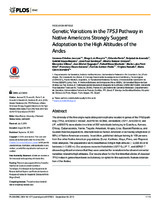Genetic variations in the TP53 pathway in native americans strongly suggest adaptation to the high altitudes of the andes

View/
Date
2015-09-18Author
Jacovas, Vanessa Cristina
Rovaris, Diego Luiz
Pérez, Orlando
Azevedo, Soledad de
Macedo, Gabriel Souza
Sandoval, José Raul
Salazar-Granara, Alberto
Villena, Mercedes
Dugoujon, Jean-Michel
Bisso-Machado, Rafael
Petzi-Erler, María Luiza
Salzano, Francisco Mauro
Ashton-Prolla, Patricia
Ramallo, Virginia
Bortolini, María Cátira
Metadata
Show full item recordAbstract
Abstract.
The diversity of the five single nucleotide polymorphisms located in genes of the TP53 pathway (TP53, rs1042522; MDM2, rs2279744; MDM4, rs1563828; USP7, rs1529916; and
LIF, rs929271) were studied in a total of 282 individuals belonging to Quechua, Aymara,
Chivay, Cabanaconde, Yanke, Taquile, Amantani, Anapia, Uros, Guarani Ñandeva, and
Guarani Kaiowá populations, characterized as Native American or as having a high level (>
90%) of Native American ancestry. In addition, published data pertaining to 100 persons
from five other Native American populations (Surui, Karitiana, Maya, Pima, and Piapoco)
were analyzed. The populations were classified as living in high altitude ( 2,500 m) or in
lowlands (< 2,500 m). Our analyses revealed that alleles USP7-G, LIF-T, and MDM2-T
showed significant evidence that they were selected for in relation to harsh environmental
variables related to high altitudes. Our results show for the first time that alleles of classical
TP53 network genes have been evolutionary co-opted for the successful human colonization of the Andes.
